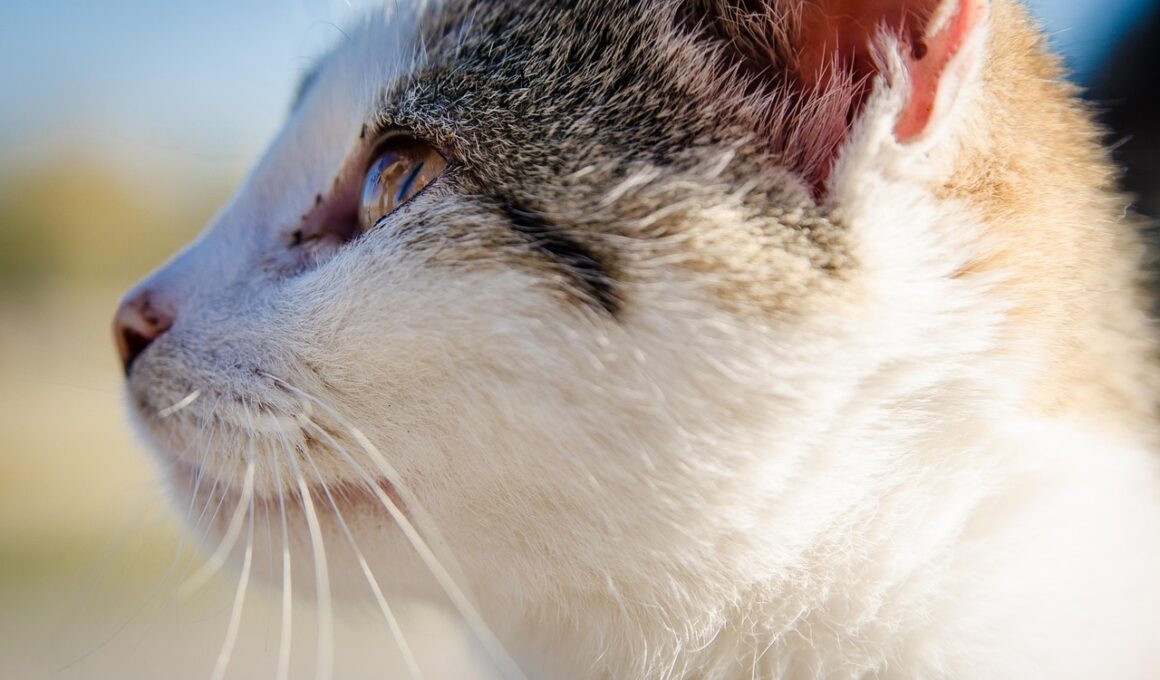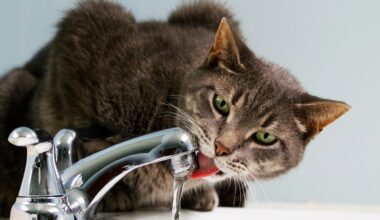Managing Resource Guarding in Cats During Vet Visits
Resource guarding in cats can present significant challenges, especially during vet visits. Understanding this behavior is essential to ensure the safety of both the pet and the veterinarian. Resource guarding may manifest as a cat protecting food, toys, or even their owner from perceived threats. These behaviors often stem from anxiety or past trauma, leading to defensive actions when they feel threatened. Learning to recognize signs such as hissing, swatting, or growling can help owners take preemptive measures. A comprehensive approach to managing this behavior is crucial. Preparing your cat for these visits involves creating positive experiences at the vet by associating the clinic environment with rewards. Gradual desensitization to the carrier and travel process can ease anxiety. Creating a calmer atmosphere by using pheromone diffusers or calming collars may also help. It’s vital for pet owners to remain patient, as some cats take longer to adjust than others. Regular visits for health checks can familiarize the cat with the visit process, reducing their stress during vet visits over time. Understanding your cat’s needs is just as important during this process.
One effective strategy for managing resource guarding during vet visits is proper socialization. Early socialization helps a cat become accustomed to handling and different environments before any negative experiences occur. Introduce your cat to various handling scenarios at home, such as being touched around common guarding areas like the paws or mouth. This technique can create a sense of trust between the cat and owner, reducing anxiety. Furthermore, using treats as rewards during these socialization sessions helps create positivity associated with handling. Gradually increasing the severity of these interactions will prepare your cat for more stressful situations, such as a vet visit. Additionally, it might be beneficial to choose veterinary clinics that are known for their cat-friendly practices to further reduce stress levels. The staff should be trained to handle cats gently and in a calm environment. If necessary, collaborate with a veterinarian who specializes in feline behavior. They can provide tailored advice and treatment options to mitigate serious resource guarding issues. A well-informed approach is crucial in addressing your cat’s specific needs in this context.
Understanding the Triggers of Resource Guarding
Identifying triggers for resource guarding in cats is essential for effective management. Each cat is unique; thus, their triggers can vary greatly. Begin by observing the situations that make your cat show defensive behavior at home. Common triggers include sudden movements, strange noises, or people approaching during feeding times. Owners should journal these observations to develop a clearer picture. Keep in mind that resource guarding may not remain static; environments change and cats may react differently based on their mood or the presence of other animals. An understanding of their triggers can help owners take preventative measures. For instance, if your cat guards their food bowl, consider separating feeding areas from high-traffic zones in the home. Providing a safe space where your cat can eat, away from distractions, can reduce their stress and defensive behavior. Remember that identifying triggers is not a one-time task; it requires ongoing observation and adjustment as your environment and your cat’s behavior change over time. Recognizing that these behaviors are rooted in anxiety can foster better communication and bonding between you and your feline friend.
Another key aspect in managing resource guarding is providing enrichment in your cat’s life. A lack of stimulation can lead to feelings of insecurity and a resultant increase in guarding behaviors. Engaging play sessions using various types of toys can enhance your cat’s confidence and provide opportunities for positive reinforcement. Offering scratching posts and interactive toys can keep your cat occupied, reducing their need to defend their resources. Creating a rich environment that includes climbing structures or puzzle feeders will also enrich your cat’s mental state. These activities provide a sense of security, minimizing the anxiety-related behaviors that lead to resource guarding. Keep in mind the importance of routine; predictability in feeding and playtimes can build trust over time. Enrichment efforts should align with your cat’s individual preferences; observe their interactions to find what activities they enjoy most. Ensure that they have their own designated space filled with comfort items that they can retreat to when feeling threatened. Implementing consistent enrichment activities can help manifest a more relaxed state in your cat during high-stress situations.
Effective Communication with Your Vet
Establishing open communication with your veterinarian is crucial for managing resource guarding during vet visits. Before arriving, discuss your cat’s behaviors with the veterinary team, ensuring they are aware of any guarding tendencies. Understanding the cat’s unique behavior patterns and triggers allows the vet to strategize an approach that minimizes stress and risk. Request that the veterinarian uses calm, gentle handling techniques that reduce the chances of defensive behavior. The more the staff understands your cat’s needs, the more they can accommodate and create a positive environment. You might also consider scheduling visits at quieter times, helping to ensure a less stressful atmosphere during check-ups. Some vets may even offer pre-visit consultations to discuss potential strategies for your cat. Additionally, be open to behavior modification advice from your vet, as it may include training tips or suggest specific products aimed at easing anxiety. Feel empowered to ask questions about handling techniques or calming solutions to use before and during visits. The goal is to work collaboratively with your veterinarian to ensure the best experience for your feline companion.
Medication may be an effective option in some cases for particularly stubborn resource guarding behaviors. Discuss with your vet the potential benefits of using calming medications. These can help ease anxiety during the vet visit and make it easier to handle your cat, particularly in stressful situations. Ensure to weigh the pros and cons of any medication prescribed. In some cases, behavioral modifications may combine with medication for a comprehensive approach. The vet may suggest anti-anxiety medications like gabapentin, which can also help during the travel process to the vet’s office. Always follow your veterinarian’s directions and monitor your cat’s reaction to any new medications. Keeping a log of your cat’s demeanor before and after medication administration can provide valuable feedback for your vet. It’s essential to remain observant and adjust the approach as necessary. Remember, medication is not the sole solution; it should accompany other strategies to effectively manage resource guarding. Create a team effort between you, your cat, and the veterinary staff to foster a calm state during visits.
Maintaining a Supportive Environment
Creating a supportive environment extends beyond the vet visits. At home, it’s essential to monitor and manage stress levels consistently. Regularly assess your cat’s interactions with other pets and household members. Conflict or high-energy environments can exacerbate resource guarding behaviors. Designate quiet areas where your cat can retreat if they feel overwhelmed. Incorporate calming aids, such as soft music or pheromone diffusers, to promote relaxation. Additionally, maintaining a consistent routine can ease anxiety by providing predictability. Feed your cat at regular intervals and allocate specific times for play and relaxation. Engaging in interactive playtime fosters trust and assertiveness. This bond can help your cat feel more secure and less inclined to guard their resources fiercely. Another technique involves practicing slow introductions with new pets or people in the home to reduce feelings of threat. It’s crucial to recognize your cat’s body language during these interactions so you can intervene if guarding behaviors arise. Gathering support from knowledgeable friends and professionals can also aid in establishing a safe and secure milieu for your feline friend.
Lastly, empathizing with your cat is key to managing resource guarding effectively. Understand that the guarding behaviors are typically rooted in fear or insecurity and do not stem from aggression for the most part. Every cat has a different personality, and an empathetic approach can help them feel safer. Spend quality time observing their behavior in various contexts and apply your findings to support their needs. Encourage positive interaction by rewarding them for calm behavior with treats or affection, reinforcing these good habits. Your understanding can create a bridge of trust, allowing your cat to feel more comfortable in unfamiliar situations like vet visits. Continually educate yourself about resource guarding and feline behavior, as knowledge can empower you in your interactions. Remaining patient through challenges can yield long-term success. It’s important to celebrate small victories throughout the journey, reinforcing the bond you share with your cat. With love, understanding, and strategic planning, you can ensure that vet visits become less stressful and more manageable for both you and your feline companion.


